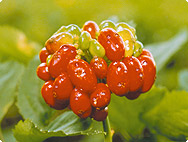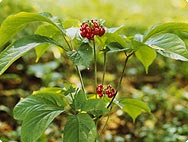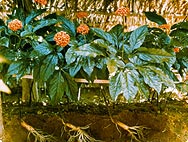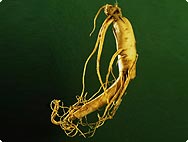A.Vogel search
When the internal search is activated, personal data such as your IP address is transmitted to our search engine Cludo. Data is thus transferred to a third country. Please click here if you want to display the internal search. You can find more information on data protection here: Privacy policy.
A.Vogel plant encyclopaedia
Panax ginseng C.A. MEYER
Ginseng
History

The first description of ginseng appeared in the legendary Chui zhang, the Chinese depiction of the Creation story. In Korea, China and Japan the root has been held in the highest esteem for over 2,000 years. According to the principles of Chinese medicine, the root strengthens kidney ”Qi“ (fortifies and prolongs life), cools fire (fever), multiplies the earth (strengthens the spleen and stomach), produces gold (supports the lungs), opens the heart, increases knowledge, causes blocked mucous to flow and is a panacea for all illnesses.
As a result of the root's resemblance to the human form, the plant was often associated with an ancient deity, giving rise to the belief that the omnipotent spirit of the mountain had sent mankind his son in the shape of a human-looking root to be their saviour, and that only those worthy of it could find the golden yellow root. Wild ginseng was a costly rarity and ginseng collectors led dangerous lives. Panax ginseng was first cultivated in Japan in 1710, in Korea in 1760 and in China in 1900. The "Korean Research Institute" in Daejon has held regular ginseng symposia since the beginning of the century. Today Panax ginseng is still the most popularly used herbal remedy in East Asia.
Ginseng was introduced to Europe in the early Middle Ages by Arabian merchants. However, ignorance about the root with the human form meant that its use was banned as "Moorish devil's stuff". Knowledge about the root's medicinal properties only became known during the seventeenth century, when the Dutch made major inroads into the Iberian monopoly on overseas trade as a result of missionaries operating in the West. Willem Piso (1611-1678) wrote the first monograph on the plant, entitled "Ninzin", which was to launch the first Ginseng boom. This was soon followed by different expert opinions. Many of Europe's rational-thinking doctors were suspicious of the much-lauded, miraculous remedy and for this reason it was omitted from most European pharmacopoeias by around 1800. Ginseng has only regained popularity in the West during the last fifty years. Since 1972, groups of researchers, such as the "Ginseng Research Institute" in New York, have been trying to break down the plant's efficacy and constituents. Nowadays the plant is one of the most thoroughly examined herbal remedies and as a result is becoming increasingly significant in the West.
The genus panax has its name from panacea, the Greek goddess of all-healing. It is composed of pan, meaning "everything" and akos, meaning "healing", thus a universal remedy. The name Ginseng contains the Chinese words gin (shin, jen) meaning "human being" and seng or shen which describes the fleshy, bitter roots. Together they make a "bitter root in the shape of a human being". This reminds us of the European mandrake whose roots also have a human shape.
Botanical characteristics

The perennial plant is upright and grows to a height of between 30 and 80cm; it has a bare, rounded stem which branches out with increasing age. The long-stemmed whorls usually bear five dark green, elongated, egg-shaped leaves of 7 to 20cm in length. 15 to 30 of the greenish white androgynous flowers form one to three umbels from which grow rounded, pea-sized, bright red, smooth shiny berries containing two seeds. The top of the yellow spindle-shaped root is divided to form hands and sometimes resembles the human form.
The plant flowers from June to July
Habitat

Wild Panax ginseng is native - although not abundant - to the shady mountain forests of eastern Asia; it grows in an area extending from Nepal to Manchuria. The plant is cultivated in northern China, Manchuria, in the Ukraine, Korea and Japan but its cultivation requires great care. A year after having sown the seeds on dry clay soil the strongest shoots are planted out in plantations where no ginseng has grown for a period of at least 10 to 15 years, in order to prevent rotting of the roots. Moreover, the plants need to be protected continually from sun and pests and must also be well and diversely fertilized. The roots are harvested in autumn between the fourth and seventh year of growth. In North America the slightly less potent type of ginseng, P. quinquefolius, is cultivated.
Preparation

A.Vogel/Bioforce uses the thickened alcohol extract made from the whole root of white ginseng to produce tablets.
Two types of ginseng root exist: white or red, depending upon how they are prepared for the market. For white ginseng, the freshly harvested roots are washed and scraped and then dried in the sun or artificially at temperatures of 100°C to 200°C. During this procedure the dark outer layers of bark surrounding the root are shed.
In China and Japan, red ginseng is officially monographed. Here, ancient methods of conservation involve steaming the freshly collected roots at a temperature of between 120°C to 130°C for two to three hours and then drying them. After the roots have been dried they are red, semi-transparent and horny in appearance. The reddish colour comes from steaming, which brings about the "Maillard reaction" (a reaction between reducing sugars and amino-acids).